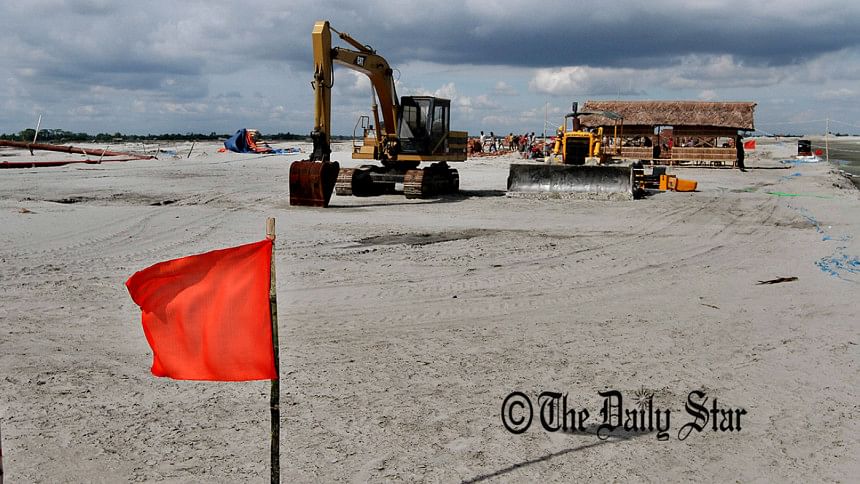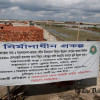Answers to some controversies

The soon to be built $1.49 billion Rampal coal-fired power plant has generated concern and controversy among the citizens, environmental experts, and government officials in the country and abroad. The main concern being the potential of irreversible damage to the unique eco-system of the world's largest mangrove forest, the Sundarbans.
Prime Minister Sheikh Hasina briefed the media on August 27 to assure all that the project would not harm the Sundarbans.
But what is the reality? Sharier Khan talked with experts and officials involved with the project or having knowledge of the project to get a clearer picture of the issues at stake. Most of the sources were not willing to talk on record. We publish extracts of the conversations here.
SOVEREIGN GUARANTEE CONTROVERSY
One of the controversial aspects of the project has been the Bangladesh government sovereign guarantee to the Indian Exim bank to obtain the loan when the plant is owned jointly by India and Bangladesh. Bangladesh has taken all financial risks, but India did not.
Except for the case of Rampal project, Bangladesh government has provided such guarantees only for a government project.
A power expert argued, “This is contradictory. This was not originally planned when the friendship company was formed. If the government gives the Indo-Bangla joint venture company such guarantee because the plant is being built in Bangladesh, why should the government not provide such guarantee to other private large power projects?”
Defending the issue, a high official said, “The government has given sovereign guarantee due to a number of reasons.”
“Firstly, no financial institution would provide such a huge loan without any sovereign guarantee. Bangladesh had listed 30 possible financial sources—but nobody was willing to give this loan,” he said.
“Secondly, the project may be under an India-Bangladesh joint venture company (that is owned by governments of two nations), but it is being built on the soil of Bangladesh where Bangladesh is sovereign—not India. Thirdly, due to the sovereign guarantee—the rate of interest turned out to be very low,” he said.
The sovereign guarantee issue has now paved way for other state-to-state joint venture initiatives in coal power. Sources said that similar deals were coming up with joint ventures with China, Malaysia and Singapore.
ROLE OF NTPC
Many have also criticized the fact that without sharing any risk, the NTPC was only investing around $200 million--but would reap the profit of the project in the long term. Bangladesh was doing many other large projects without such configuration. Therefore, what is the justification of having a joint venture with the NTPC.
“Firstly the Indo-Bangla company is a demonstration of friendship between the two countries, which ultimately aims at building mutual confidence. Secondly, Bangladesh has little knowledge in handling coal power. The NTPC has vast experience in running coal power plants and import of coal. They know how to handle coal and how to select coal,” said the power official.
“The NTPC that handles 45,000 mw power generation, is here to transfer knowledge. Its expert helped the friendship company to prepare tender documents in a transparent way. Then the NTPC knowledge would help with the management of the power station later on,” he added.
“The NTPC's profile alongside the BPDB's profile has been a factor in securing the loan,” he pointed out.
TARIFF
At the initial stage of the Rampal project, the NTPC gave a forecast that power tariff from this plant could become as high as Tk 8 per kilowatt hour (or a unit). In contrast, the power cost of the 16-year old Meghnaghat 450 MW private power project is just around Tk 2.3 per unit. The government's recent deals with private companies like Orion and S Alam Group to build coal power plants also dictate power tariff of around Tk 3.5 per unit, therefore, the Rampal power cost is clearly way too high.
A former high official of the BPDB noted that at present times, the cost of building power plants has gone up. “Whether Orion or S Alam can actually build any power plant based on Tk 3.5 per unit tariff remains a big question as none of these companies could make any major headway with their projects in the last two-three years,” he pointed out, “but yes, Tk 8 per unit is way too high for coal power anywhere in the world.”
“Rampal's power cost would not be Tk 8 per unit. It would be between Tk 5 and Tk 6,” said a power ministry official.
“That estimate was done long ago based on the information given to India by the BPDB. Many factors have changed by now. For instance, the cost of coal used to be $100. It's now $50 per tonne. Back then, the project financing was not secured. Therefore the cost of debt was estimated at 14 percent. Now we have secured loan at 1 percent interest (plus Libor). As a result the cost would be much lower,” he said.
“One important factor in fixing power tariff is to consider that no two project cost would be exactly the same if they are built in two different locations. The Rampal location demands comparatively higher construction cost because of its soil condition. Plus we need to invest in desalination of water from the Passur river for power generation--whereas if we built a plant further north, we could have availed regular water and saved this investment,” he added.
Another factor for comparatively higher cost is Bangladesh's wish to use the best coal with least hazardous pollutants; and the use of ultra-super critical generator. “Bangladesh chose to invest more on better quality equipment and coal for the sake of environment. If you want things better, you have to spend more money,” he pointed out.
DREDGING ISSUE
Coal for the Rampal plant will be transported through the Passur river from the Akram Point up to Rampal. For this, around 6 kilometer area of the Passur river would need dredging. Critics say, the dredging cost has not been calculated with the Rampal power cost and therefore the actual power generation cost would be erroneous.
“This river is under the jurisdiction of the Mongla port authority,” said the official. The Mongla port authority regularly dredges various channels that are commercially used.
“It would dredge the river for coal transportation and charge the power plant company for each mini ship at a rate fixed by the government,” he added. “This cost would be reflected in the power tariff.”
The coal ships would require a draft of 5.5 meter in Passur and most part of the river has this draft.
COAL HANDLING
Another major concern for environmentalists is regular transportation and handling of coal on small barges through the Passur river in the Sundarbans from Akram Point where the coal would be dispatched from larger ships. There is a risk of environmental disaster if such barges sink—as some petroleum carrying barges had sunk in the recent times; plus while loading and unloading coal, possibilities of coal dust spreading is very high. In the long term, this would be disastrous, environmentalists say.
“The NTPC has the experience of importing and handling 14-15 million tonnes of coal per year,” said a power ministry official. “For the Rampal project, we will import coal from Indonesia or South Africa,” he added.
“This plant would need 12,000 tonnes of coal daily. The company would procure some modern mini-ships of European standard. There will be no question of disasters (like the ones that sunk in the Sundarbans channels in recent years)—because these are proper ships,” the official noted.
“Secondly, such mini ships will have the capacity to carry 10,000 tonnes of coal. So there won't be a lot of activities in the river through the forest,” he added.
“The ships will be completely covered. So coal dust would not spread around the forest as many fear,” he said.
However there will still be risk of coal dust release at Akram Point where the mini ships would load coal from the large ships.
ASH AND MERCURY HANDLING
There is a concern that the plant would release ash into the air and thus pollute the Sundarbans.
But power ministry officials say the power plant will have a chimney that is more than 900 feet tall to ensure that the emission is released so high that it would not affect the adjacent area. Plus, the plant is being equipped with Electrostatic Precipitator (ESP) that has 99.9% efficiency to arrest fly ash.
“Alongside ash, the ESP can also trap mercury content—which would be very low,” noted the official. “Any mercury left would be then absorbed by another mechanism within the power plant,” he added.
Then how would the plant dump the ash?
“We are not going to dump ash anywhere. Firstly fly ash can replace the use of top soil in making bricks. So we are going to sell the fly ash to the brick factories across the country,” he pointed out.
“After the ash is collected by the ESP, it will be deposited in an ash silo. The ash would then be loaded in special trucks and barges to send them to buyers,” he said, “the NTPC has experience in handling fly ash this way.”
“In case we need to store some ash, we will build a high concentration slurry disposal (HCSD) at the plant site where ash will be pumped like toothpaste and sent to a contingency ash dike. This paste will turn into ash stone within hours,” he pointed out.
“Finally, other than the BPDB, the NTPC also does not want to ruin its reputation by being involved in a project that would destroy a world heritage forest. So the company is taking calculated measures from its part,” he pointed out.

 For all latest news, follow The Daily Star's Google News channel.
For all latest news, follow The Daily Star's Google News channel. 





Comments